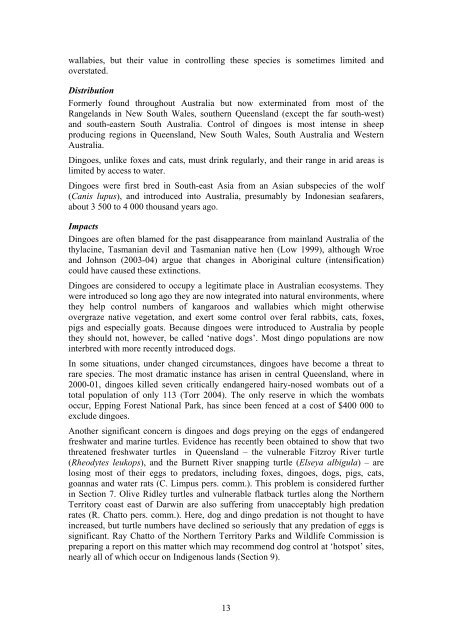Review of the management of feral animals and their impact on ...
Review of the management of feral animals and their impact on ...
Review of the management of feral animals and their impact on ...
You also want an ePaper? Increase the reach of your titles
YUMPU automatically turns print PDFs into web optimized ePapers that Google loves.
wallabies, but <str<strong>on</strong>g>the</str<strong>on</strong>g>ir value in c<strong>on</strong>trolling <str<strong>on</strong>g>the</str<strong>on</strong>g>se species is sometimes limited <str<strong>on</strong>g>and</str<strong>on</strong>g><br />
overstated.<br />
Distributi<strong>on</strong><br />
Formerly found throughout Australia but now exterminated from most <str<strong>on</strong>g>of</str<strong>on</strong>g> <str<strong>on</strong>g>the</str<strong>on</strong>g><br />
Rangel<str<strong>on</strong>g>and</str<strong>on</strong>g>s in New South Wales, sou<str<strong>on</strong>g>the</str<strong>on</strong>g>rn Queensl<str<strong>on</strong>g>and</str<strong>on</strong>g> (except <str<strong>on</strong>g>the</str<strong>on</strong>g> far south-west)<br />
<str<strong>on</strong>g>and</str<strong>on</strong>g> south-eastern South Australia. C<strong>on</strong>trol <str<strong>on</strong>g>of</str<strong>on</strong>g> dingoes is most intense in sheep<br />
producing regi<strong>on</strong>s in Queensl<str<strong>on</strong>g>and</str<strong>on</strong>g>, New South Wales, South Australia <str<strong>on</strong>g>and</str<strong>on</strong>g> Western<br />
Australia.<br />
Dingoes, unlike foxes <str<strong>on</strong>g>and</str<strong>on</strong>g> cats, must drink regularly, <str<strong>on</strong>g>and</str<strong>on</strong>g> <str<strong>on</strong>g>the</str<strong>on</strong>g>ir range in arid areas is<br />
limited by access to water.<br />
Dingoes were first bred in South-east Asia from an Asian subspecies <str<strong>on</strong>g>of</str<strong>on</strong>g> <str<strong>on</strong>g>the</str<strong>on</strong>g> wolf<br />
(Canis lupus), <str<strong>on</strong>g>and</str<strong>on</strong>g> introduced into Australia, presumably by Ind<strong>on</strong>esian seafarers,<br />
about 3 500 to 4 000 thous<str<strong>on</strong>g>and</str<strong>on</strong>g> years ago.<br />
Impacts<br />
Dingoes are <str<strong>on</strong>g>of</str<strong>on</strong>g>ten blamed for <str<strong>on</strong>g>the</str<strong>on</strong>g> past disappearance from mainl<str<strong>on</strong>g>and</str<strong>on</strong>g> Australia <str<strong>on</strong>g>of</str<strong>on</strong>g> <str<strong>on</strong>g>the</str<strong>on</strong>g><br />
thylacine, Tasmanian devil <str<strong>on</strong>g>and</str<strong>on</strong>g> Tasmanian native hen (Low 1999), although Wroe<br />
<str<strong>on</strong>g>and</str<strong>on</strong>g> Johns<strong>on</strong> (2003-04) argue that changes in Aboriginal culture (intensificati<strong>on</strong>)<br />
could have caused <str<strong>on</strong>g>the</str<strong>on</strong>g>se extincti<strong>on</strong>s.<br />
Dingoes are c<strong>on</strong>sidered to occupy a legitimate place in Australian ecosystems. They<br />
were introduced so l<strong>on</strong>g ago <str<strong>on</strong>g>the</str<strong>on</strong>g>y are now integrated into natural envir<strong>on</strong>ments, where<br />
<str<strong>on</strong>g>the</str<strong>on</strong>g>y help c<strong>on</strong>trol numbers <str<strong>on</strong>g>of</str<strong>on</strong>g> kangaroos <str<strong>on</strong>g>and</str<strong>on</strong>g> wallabies which might o<str<strong>on</strong>g>the</str<strong>on</strong>g>rwise<br />
overgraze native vegetati<strong>on</strong>, <str<strong>on</strong>g>and</str<strong>on</strong>g> exert some c<strong>on</strong>trol over <str<strong>on</strong>g>feral</str<strong>on</strong>g> rabbits, cats, foxes,<br />
pigs <str<strong>on</strong>g>and</str<strong>on</strong>g> especially goats. Because dingoes were introduced to Australia by people<br />
<str<strong>on</strong>g>the</str<strong>on</strong>g>y should not, however, be called ‘native dogs’. Most dingo populati<strong>on</strong>s are now<br />
interbred with more recently introduced dogs.<br />
In some situati<strong>on</strong>s, under changed circumstances, dingoes have become a threat to<br />
rare species. The most dramatic instance has arisen in central Queensl<str<strong>on</strong>g>and</str<strong>on</strong>g>, where in<br />
2000-01, dingoes killed seven critically endangered hairy-nosed wombats out <str<strong>on</strong>g>of</str<strong>on</strong>g> a<br />
total populati<strong>on</strong> <str<strong>on</strong>g>of</str<strong>on</strong>g> <strong>on</strong>ly 113 (Torr 2004). The <strong>on</strong>ly reserve in which <str<strong>on</strong>g>the</str<strong>on</strong>g> wombats<br />
occur, Epping Forest Nati<strong>on</strong>al Park, has since been fenced at a cost <str<strong>on</strong>g>of</str<strong>on</strong>g> $400 000 to<br />
exclude dingoes.<br />
Ano<str<strong>on</strong>g>the</str<strong>on</strong>g>r significant c<strong>on</strong>cern is dingoes <str<strong>on</strong>g>and</str<strong>on</strong>g> dogs preying <strong>on</strong> <str<strong>on</strong>g>the</str<strong>on</strong>g> eggs <str<strong>on</strong>g>of</str<strong>on</strong>g> endangered<br />
freshwater <str<strong>on</strong>g>and</str<strong>on</strong>g> marine turtles. Evidence has recently been obtained to show that two<br />
threatened freshwater turtles in Queensl<str<strong>on</strong>g>and</str<strong>on</strong>g> – <str<strong>on</strong>g>the</str<strong>on</strong>g> vulnerable Fitzroy River turtle<br />
(Rheodytes leukops), <str<strong>on</strong>g>and</str<strong>on</strong>g> <str<strong>on</strong>g>the</str<strong>on</strong>g> Burnett River snapping turtle (Elseya albigula) – are<br />
losing most <str<strong>on</strong>g>of</str<strong>on</strong>g> <str<strong>on</strong>g>the</str<strong>on</strong>g>ir eggs to predators, including foxes, dingoes, dogs, pigs, cats,<br />
goannas <str<strong>on</strong>g>and</str<strong>on</strong>g> water rats (C. Limpus pers. comm.). This problem is c<strong>on</strong>sidered fur<str<strong>on</strong>g>the</str<strong>on</strong>g>r<br />
in Secti<strong>on</strong> 7. Olive Ridley turtles <str<strong>on</strong>g>and</str<strong>on</strong>g> vulnerable flatback turtles al<strong>on</strong>g <str<strong>on</strong>g>the</str<strong>on</strong>g> Nor<str<strong>on</strong>g>the</str<strong>on</strong>g>rn<br />
Territory coast east <str<strong>on</strong>g>of</str<strong>on</strong>g> Darwin are also suffering from unacceptably high predati<strong>on</strong><br />
rates (R. Chatto pers. comm.). Here, dog <str<strong>on</strong>g>and</str<strong>on</strong>g> dingo predati<strong>on</strong> is not thought to have<br />
increased, but turtle numbers have declined so seriously that any predati<strong>on</strong> <str<strong>on</strong>g>of</str<strong>on</strong>g> eggs is<br />
significant. Ray Chatto <str<strong>on</strong>g>of</str<strong>on</strong>g> <str<strong>on</strong>g>the</str<strong>on</strong>g> Nor<str<strong>on</strong>g>the</str<strong>on</strong>g>rn Territory Parks <str<strong>on</strong>g>and</str<strong>on</strong>g> Wildlife Commissi<strong>on</strong> is<br />
preparing a report <strong>on</strong> this matter which may recommend dog c<strong>on</strong>trol at ‘hotspot’ sites,<br />
nearly all <str<strong>on</strong>g>of</str<strong>on</strong>g> which occur <strong>on</strong> Indigenous l<str<strong>on</strong>g>and</str<strong>on</strong>g>s (Secti<strong>on</strong> 9).<br />
13
















